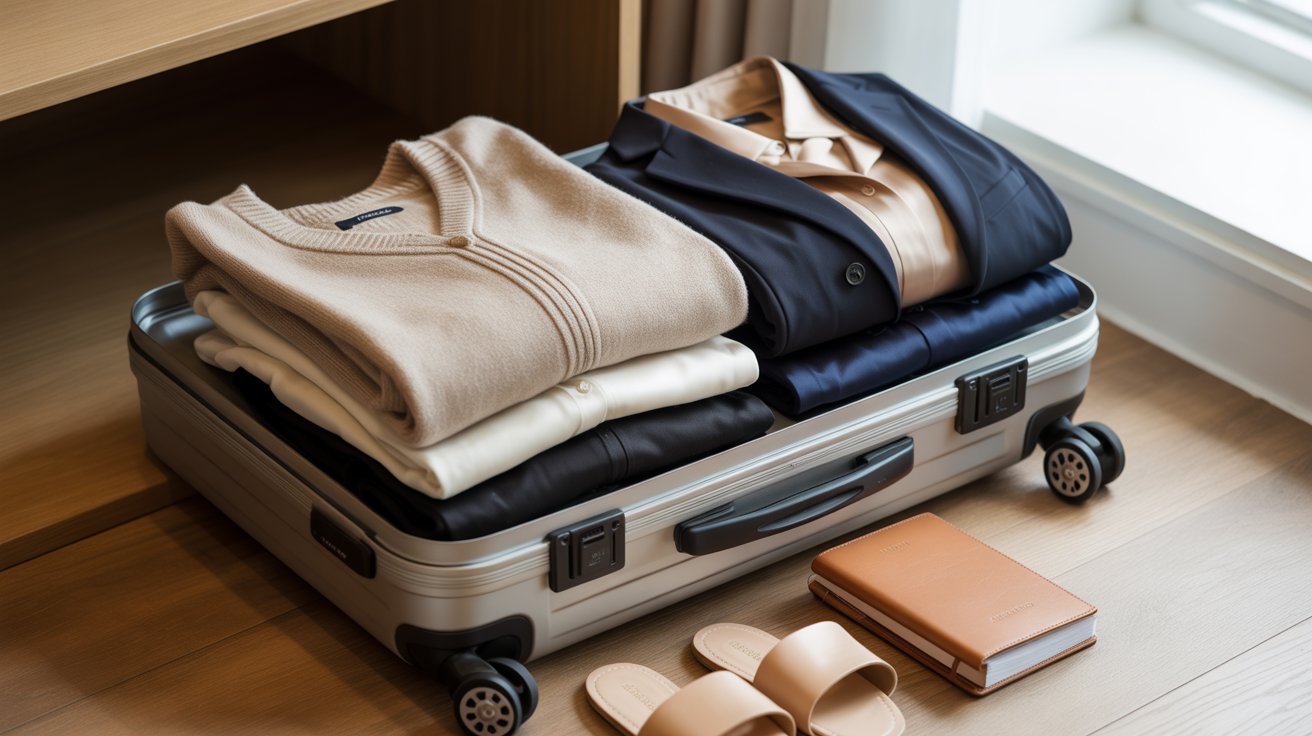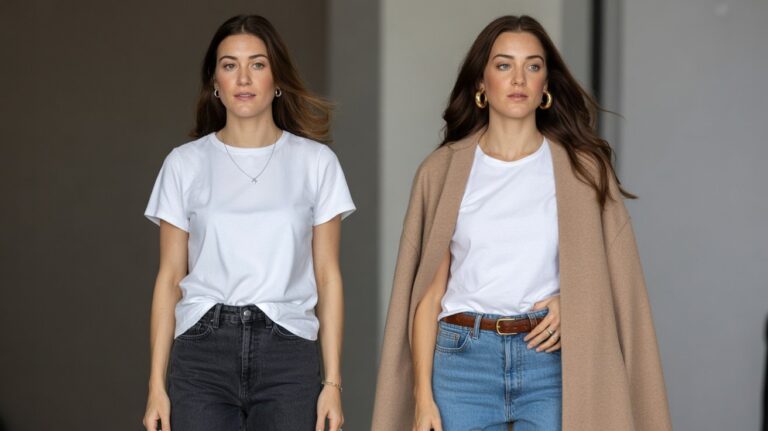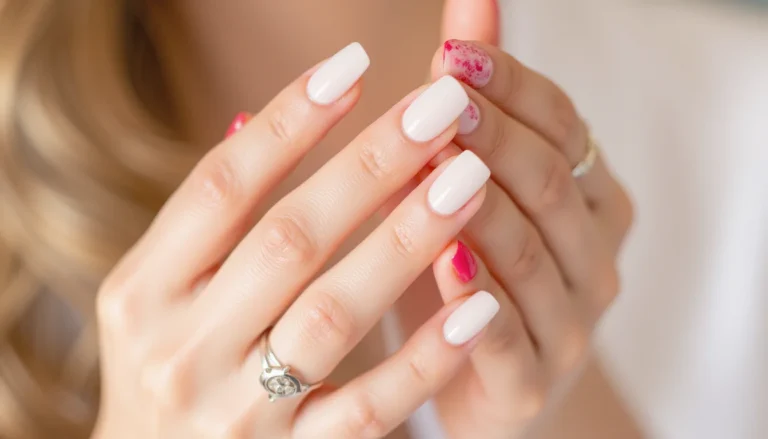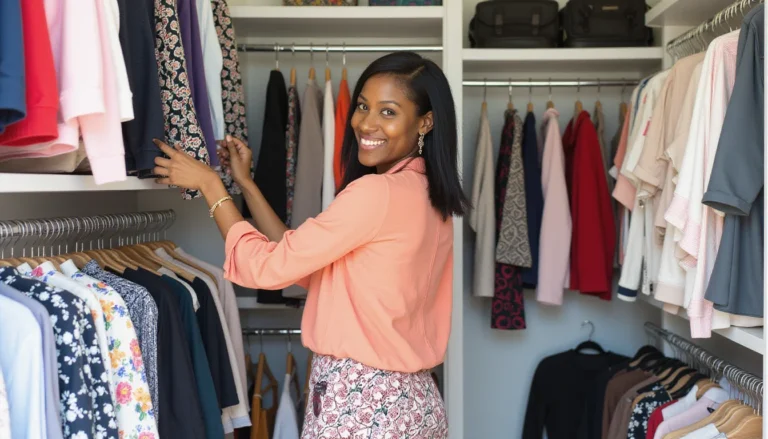How to Pack a Capsule Travel Wardrobe That Works in Any Climate: The Ultimate Guide to Climate-Adaptive Travel Fashion
Just imagine You’re standing in your hotel room in Iceland at 6 AM, watching the Northern Lights dance across the sky in 30°F weather. By noon, you’ll be boarding a flight to Greece where it’s 85°F and sunny. Tomorrow? You’ll be hiking through Scotland’s unpredictable weather that could swing from rain to sunshine in minutes.
Sound impossible to pack for? I used to think so too.
After getting caught in a monsoon in Thailand wearing nothing but cotton shorts and a tank top (spoiler alert: cotton + tropical rain = disaster), I knew I needed a system. Not just any packing method, but a climate-adaptive capsule wardrobe that could handle Mother Nature’s curveballs while keeping me comfortable, confident, and luggage-light.
Climate change is making weather patterns increasingly unpredictable. Research published in Nature Climate Change shows that tourism’s global carbon footprint has grown to 4.5 GtCO2e annually, while simultaneously, travelers face more extreme weather variations than ever before. The need for truly adaptive travel wardrobes has never been more critical.
The result? A revolutionary approach that combines cutting-edge fabric technology with strategic layering systems, allowing you to pack just 15-20 versatile pieces that work seamlessly across temperature ranges from arctic cold to tropical heat.
Why Traditional Packing Methods Fail in Multiple Climates
Most travel capsule guides assume you’re visiting one climate zone. They’ll tell you to pack “weather-appropriate” clothes, but what happens when your itinerary spans three seasons and four time zones? This challenge is becoming increasingly common as UN Tourism research shows that transport-related CO2 emissions from tourism are expected to account for 5.3% of all man-made emissions by 2030, with tourists increasingly seeking diverse, multi-destination experiences. You end up with either:
- The Overpacker’s Dilemma: Three massive suitcases for every possible weather scenario
- The Underpacker’s Nightmare: Shivering in Prague because you only packed for Rome’s summer weather
- The One-Climate Trap: Perfect for the beach, useless everywhere else
The bottom line: Traditional methods fail because they don’t account for climate transitions, unexpected weather changes, and the reality of modern multi-destination travel.
The Science Behind Climate-Adaptive Fabrics
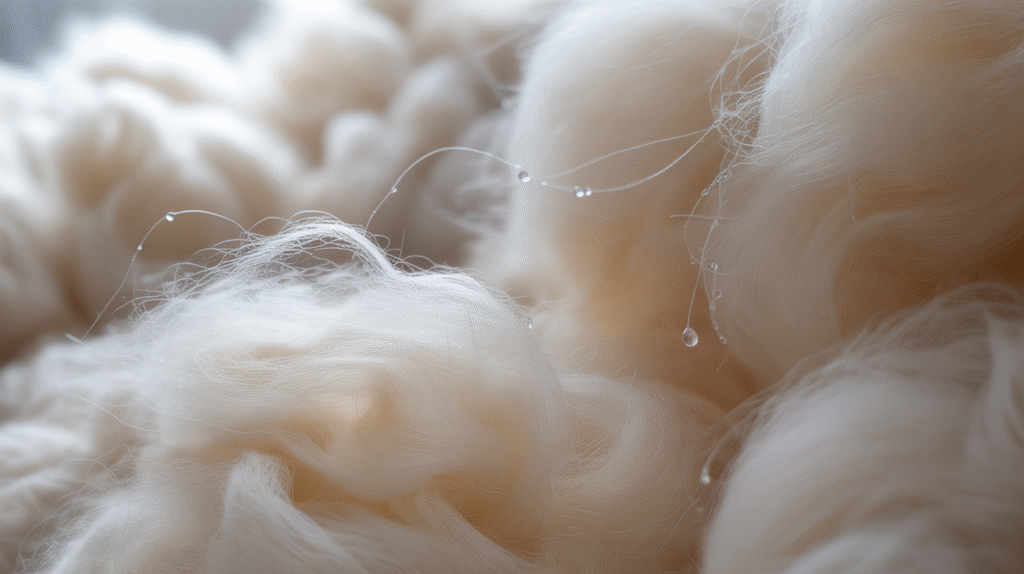
Before diving into packing strategies, understanding fabric technology is crucial for creating a truly versatile wardrobe. Modern textiles have revolutionized travel clothing, making it possible to pack lighter while staying comfortable in any climate.
The Big Four: Climate-Adaptive Fabric Technologies
1. Merino Wool: The Temperature Regulator
- Why it works: Natural crimp creates air pockets that insulate when cold, release heat when warm
- Climate range: Effective from 20°F to 80°F
- Superpower: Naturally antimicrobial (wear 3-5 days without washing)
- Best for: Base layers, sweaters, socks
Recent breakthrough research from North Carolina State University confirms that 100% merino wool base-layer garments deliver superior thermal comfort during dynamic stop-go activities, maintaining thermal equilibrium during both exertion and rest periods—making it scientifically proven as the ideal fabric for climate-adaptive travel.
2. Moisture-Wicking Synthetics: The Quick-Dry Champions
- Why it works: Synthetic fibers transport moisture away from skin to fabric surface
- Climate range: Excellent for hot, humid conditions (70°F+)
- Superpower: Dries in 2-4 hours
- Best for: Athletic wear, underwear, hot climate shirts
3. Tencel/Lyocell: The Adaptive Hybrid
- Why it works: Plant-based fiber that’s cooler than cotton, warmer than linen
- Climate range: Comfortable from 50°F to 85°F
- Superpower: Naturally antibacterial and biodegradable
- Best for: Dresses, blouses, pajamas
4. Performance Cotton Blends: The Upgraded Classic
- Why it works: Cotton comfort with synthetic performance enhancements
- Climate range: Moderate temperatures (55°F to 75°F)
- Superpower: Familiar feel with improved durability
- Best for: Casual shirts, jeans, everyday pieces
The Layering Science: How Professional Outdoor Athletes Pack
Professional mountaineers and extreme weather travelers use a three-layer system that we can adapt for civilian travel:
Layer 1 (Base): Moisture management – keeps skin dry Layer 2 (Mid): Insulation – traps warm air or releases heat Layer 3 (Shell): Protection – shields from wind, rain, or intense sun
This system works because you can add or remove layers as conditions change, essentially carrying multiple climate wardrobes in one compact package.
The Climate-Adaptive Capsule Formula: 15-20 Pieces for Any Weather
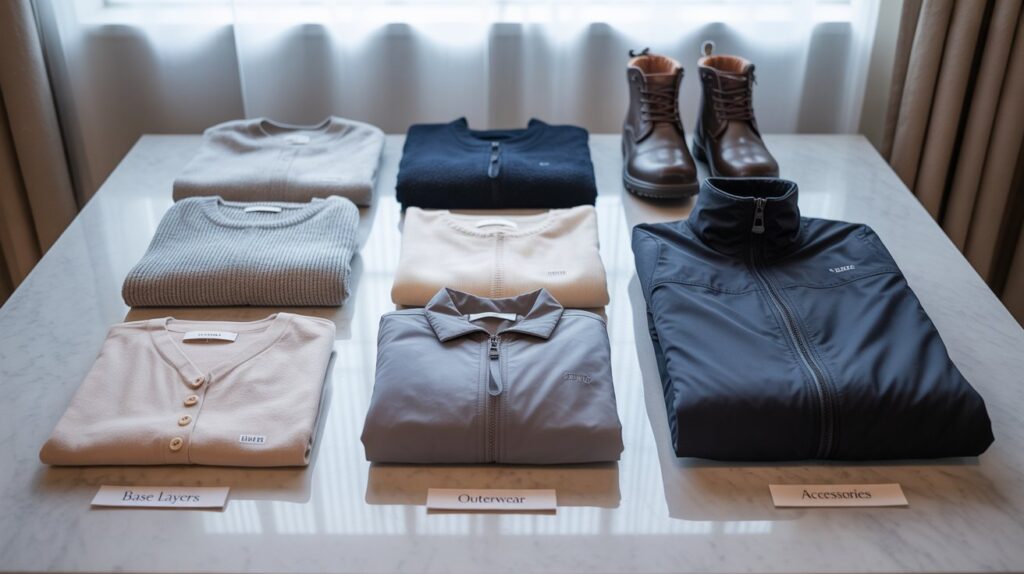
Forget rigid formulas like 5-4-3-2-1. Instead, use this flexible Climate-Adaptive Formula that adjusts based on your destination mix:
Core Foundation (8-10 pieces) – Works in Any Climate
- 3 Base Layers: 1 merino wool, 1 moisture-wicking, 1 cotton blend
- 2 Versatile Bottoms: 1 technical pant, 1 classic (jeans/chinos)
- 1 Universal Dress: Wrinkle-resistant, works casual to dressy
- 2 Mid-Layers: 1 light cardigan/hoodie, 1 button-down shirt
- 2 Footwear: 1 walking shoe, 1 weather-specific shoe
Climate Modules (Choose 2-3 based on your destinations)
Hot Climate Module (+3-4 pieces)
- Lightweight shorts
- Breathable tank/tee
- Sun protection shirt (UPF)
- Sandals or breathable flats
Cold Climate Module (+3-4 pieces)
- Insulated jacket or wool coat
- Warm bottoms (thermal leggings/wool pants)
- Warm accessories (hat, gloves)
- Insulated footwear
Wet Climate Module (+2-3 pieces)
- Packable rain jacket
- Quick-dry pants
- Water-resistant shoes
Transition Climate Module (+2-3 pieces)
- Versatile blazer/light jacket
- Scarf or lightweight wrap
- Comfortable flats or loafers
Activity-Specific Add-Ons (As needed)
- Business Travel: +1 blazer, +1 dress shirt, +1 dress shoes
- Outdoor Adventures: +1 hiking boots, +1 technical shirt
- Beach Destinations: +1 swimwear, +1 cover-up, +1 flip-flops
Interactive Capsule Wardrobe Planner
🧳 Climate Capsule Wardrobe Planner
Select your destination climates to get a personalized packing list
🌴 Hot & Tropical
Beach, desert, tropical cities
🍂 Temperate
Spring/fall, mild cities
❄️ Cold & Winter
Mountains, winter
🌧️ Wet & Rainy
Monsoon, rainforests
💼 Business
Meetings, conferences
🥾 Adventure
Hiking, camping
Your Personalized Capsule Wardrobe
Climate-Specific Packing Strategies
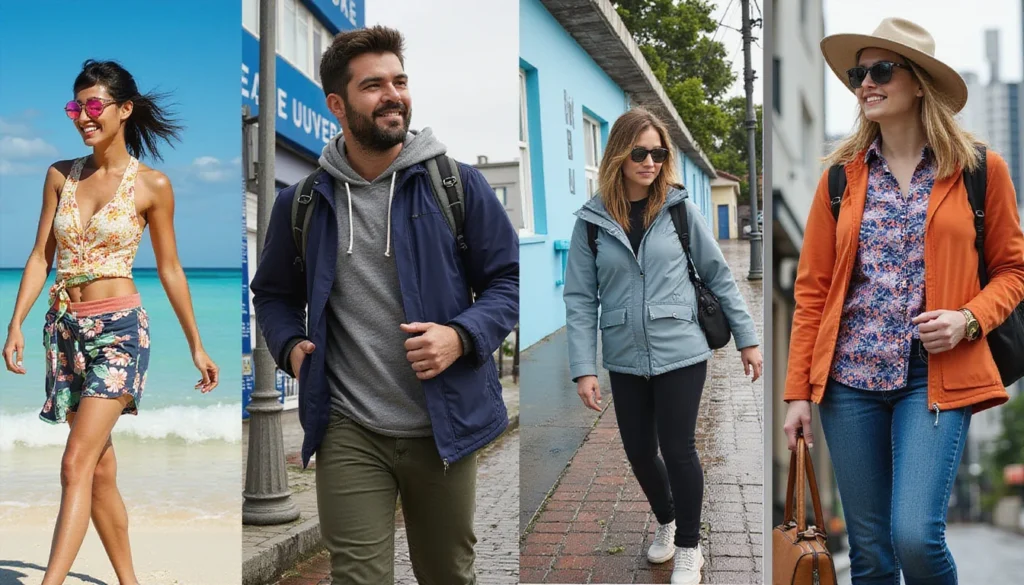
The Hot Climate Mastery System
Traveling to hot climates isn’t just about packing lightweight clothes—it’s about managing heat, humidity, and intense sun while maintaining style and comfort.
The Hot Climate Hierarchy:
- Moisture Management: Synthetic blends or merino wool that wick sweat
- Sun Protection: UPF-rated fabrics (aim for UPF 30+)
- Breathability: Loose weaves, natural fibers, ventilation features
- Quick-Dry Factor: Essential for humidity and sudden rain
Pro Hot Climate Hacks:
- The Ice Shirt Technique: Pack one extra shirt and store it in hotel mini-fridges for instant cooling
- Strategic White: Light colors reflect heat—save dark colors for evening
- The Layering Paradox: Even in hot climates, pack one light layer for over-aggressive air conditioning
The Cold Climate Survival Guide
Cold weather packing is about creating a microclimate system around your body while maintaining mobility and style.
The Warmth Equation: Insulation + Moisture Management + Wind Protection = Comfortable Warmth
Advanced Cold Climate Strategies:
- The Russian Doll Method: Each layer should be slightly larger than the one underneath
- Extremity Priority: 40% of body heat escapes through head, hands, and feet
- The 20% Rule: Pack 20% more warmth than weather forecasts suggest—you can always remove layers
Game-Changing Cold Climate Items:
- Merino wool base layers: Warm when wet, naturally antimicrobial
- Down alternatives: Synthetic insulation that works when damp
- Packable heat: Items that compress small but provide disproportionate warmth
The Wet Climate Waterproof System
Rain doesn’t have to ruin your travel style. The key is creating a three-tier water protection system:
Tier 1: Water Resistance (light rain, 10-15 minutes)
- DWR-coated jackets and pants
- Water-resistant footwear
Tier 2: Waterproof (moderate rain, 30+ minutes)
- Sealed seam jackets
- Waterproof shoes with good traction
Tier 3: Storm Protection (heavy rain, extended exposure)
- Full rain suits
- Waterproof bags for electronics and documents
The Wet Climate Mindset Shift: Think “dry fast” instead of “stay dry.” Modern technical fabrics make it possible to get wet and dry quickly, rather than trying to avoid moisture entirely.
Advanced Layering Systems for Climate Transitions
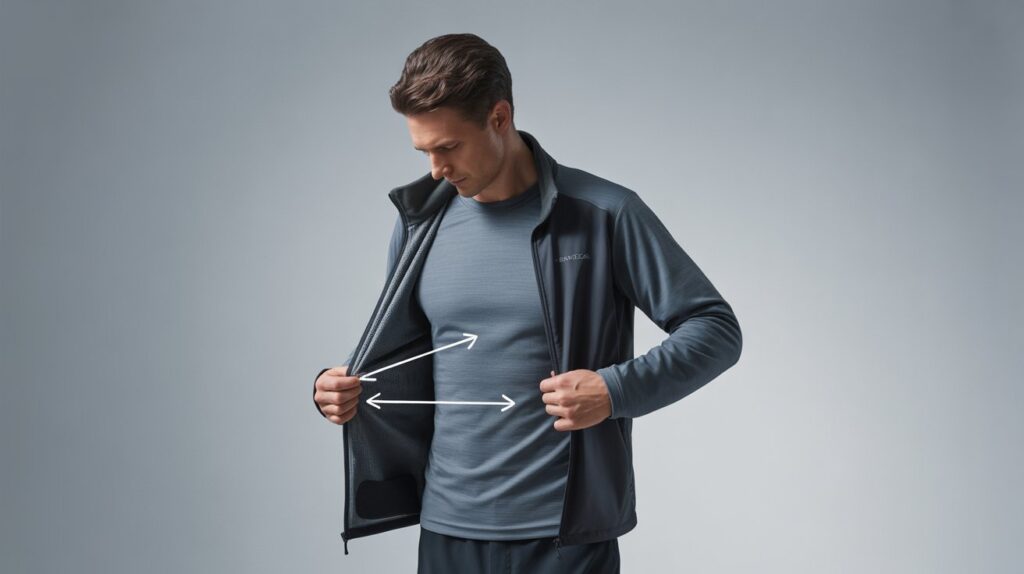
The Professional Traveler’s Layering Matrix
This system allows you to transition seamlessly between climates without changing your entire outfit:
Base Configuration (Works 50°F-70°F):
- Merino wool or moisture-wicking base layer
- Mid-weight shirt or blouse
- Comfortable pants or skirt
- Versatile shoes
Adding Warmth (For 30°F-50°F):
- Light insulation layer (cardigan, vest, light fleece)
- Outer shell (jacket, coat, windbreaker)
- Warm accessories (hat, gloves, scarf)
- Insulated footwear or warm socks
Reducing Heat (For 70°F-90°F+):
- Remove outer layers
- Switch to lighter base layer or tank
- Add sun protection (hat, sunglasses)
- Switch to breathable footwear
The 15-Minute Climate Transition Challenge
Can you transition your outfit from cold to hot weather in 15 minutes? This challenge helps you test your layering system:
Start: Dressed for 40°F weather Goal: Comfortable for 80°F weather Time Limit: 15 minutes Allowed: Only items in your capsule wardrobe
If you can’t make this transition smoothly, revise your capsule selection.
The Sustainable Capsule Wardrobe Approach
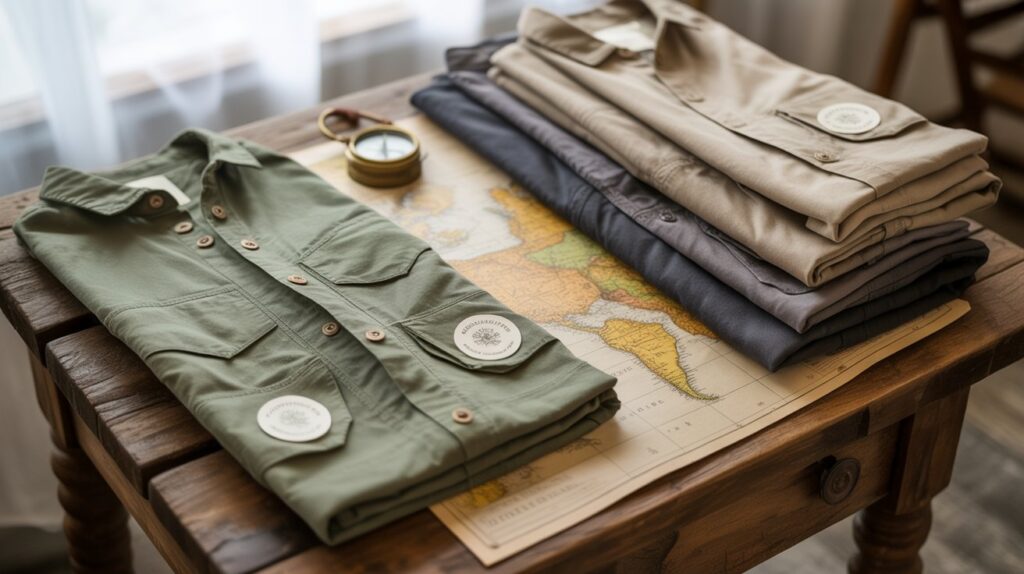
Why Sustainability Matters in Travel Fashion
The fashion industry produces 10% of global carbon emissions and 20% of global wastewater, according to United Nations Environment Programme research. The European Environment Agency reports that textile purchases in the EU generate about 355 kg of CO2 emissions per person annually—equivalent to driving 1,800 km in a standard car. By creating a thoughtful capsule wardrobe, you’re not just packing smart—you’re reducing your environmental impact.
The Sustainability Multiplier Effect:
- Fewer items = Less production impact
- Higher quality = Longer-lasting clothes
- Versatile pieces = Reduced need for new purchases
- Efficient packing = Lower transportation emissions
Building an Ethical Climate-Adaptive Wardrobe
Tier 1: Shop Your Closet First Before buying anything new, audit your existing wardrobe using these criteria:
- ✅ Can this work in multiple climates?
- ✅ Is it comfortable for 8+ hours of wear?
- ✅ Does it mix and match with other pieces?
- ✅ Is it appropriate for your travel activities?
Tier 2: Strategic Sustainable Shopping When you do need new pieces, prioritize:
- Certified organic or recycled materials
- Fair trade and ethical labor practices
- Local or regional brands (reduced shipping emissions)
- Timeless designs over fast fashion trends
Tier 3: The Cost-Per-Wear Revolution Calculate the true value of each piece: Cost-Per-Wear = Purchase Price ÷ Number of Times Worn
A $200 merino wool sweater worn 100 times costs $2 per wear. A $30 synthetic sweater worn 10 times costs $3 per wear. Quality wins.
Sustainable Fabric Choices for Climate Adaptability
Best Sustainable Options:
- Merino Wool: Renewable, biodegradable, naturally antimicrobial
- Organic Cotton: Reduced chemical use, better for soil health
- Tencel/Lyocell: Made from sustainable wood sources
- Recycled Synthetics: Gives new life to plastic waste
- Hemp: Requires minimal water, improves soil health
Avoid When Possible:
- Conventional cotton (high water and chemical use)
- Virgin synthetics (petroleum-based)
- Blends that can’t be recycled
Troubleshooting Common Capsule Wardrobe Problems
Problem #1: “Everything Looks the Same”
Symptoms: Feeling boring, lack of outfit variety, style fatigue Root Cause: Insufficient accent pieces or too narrow color palette
Solutions:
- The 80/20 Rule: 80% neutrals, 20% personality pieces
- Strategic accessories: Scarves, jewelry, and bags create variety
- Texture mixing: Combine smooth and textured fabrics
- The signature piece: One item that reflects your personal style
Problem #2: “It’s Too Bulky for My Luggage”
Symptoms: Overstuffed bags, weight limit issues, can’t zip suitcase Root Cause: Wrong fabric choices or inefficient packing techniques
Solutions:
- Fabric density audit: Replace heavy items with lighter alternatives
- The roll vs. fold test: Some items pack smaller when rolled, others when folded
- Compression packing cubes: Can reduce volume by 30-40%
- The one-week rule: If you can’t pack for one week, you can’t pack for one month
Problem #3: “I’m Always Too Hot or Too Cold”
Symptoms: Uncomfortable temperature regulation, frequent outfit changes Root Cause: Poor layering system or wrong fabric technologies
Solutions:
- Personal thermostat awareness: Track when you’re comfortable vs. uncomfortable
- The microclimate test: How do you feel in air conditioning? Humidity? Wind?
- Fabric technology upgrade: Invest in true temperature-regulating materials
- Strategic timing: Change layers before you become uncomfortable, not after
Problem #4: “I Can’t Dress Up for Nice Occasions”
Symptoms: Feeling underdressed, limited formal options, style anxiety Root Cause: Insufficient versatile pieces that transition from casual to dressy
Solutions:
- The transformer test: Each piece should work in at least 2 different formality levels
- Strategic accessories: Jewelry, scarves, and shoes can elevate any outfit
- Fabric quality focus: Higher-quality basics automatically look more polished
- The layer-up strategy: Blazers and cardigans instantly elevate casual pieces
Your 7-Day Capsule Wardrobe Implementation Plan
Day 1-2: Assessment and Audit
- Climate research: List all destinations and their weather patterns
- Activity planning: Note specific activities (business meetings, hiking, beach days)
- Closet audit: Identify existing pieces that could work in your capsule
- Gap identification: Note what you need to buy, borrow, or replace
Day 3-4: Strategic Shopping and Testing
- Quality over quantity: Invest in 2-3 high-quality pieces rather than 6-7 cheaper ones
- Fitting room testing: Try on complete outfits, not just individual pieces
- Movement test: Sit, walk, reach—ensure comfort in all positions
- Mix-and-match verification: Each new piece should work with at least 4 existing pieces
Day 5-6: System Creation and Packing Practice
- Color coordination: Arrange pieces by color families to identify gaps
- Outfit mapping: Plan 3-5 complete outfits for each climate zone
- Packing practice: Do a full pack and weigh your luggage
- Adjustment round: Remove pieces that don’t earn their space
Day 7: Final Preparation and Documentation
- Emergency backup: Identify 1-2 pieces you could buy at your destination if needed
- Care instruction review: Know how to wash everything in hotel sinks
- Outfit photo documentation: Take photos of successful combinations for reference
- Confidence check: Do you feel excited about every piece you’re bringing?
The Psychology of Successful Capsule Travel
Overcoming Decision Fatigue
The Obama Effect: President Obama wore only gray or navy suits to reduce decision fatigue for more important choices. Apply this principle to travel by:
- Morning automation: Plan outfits the night before
- Weather-based defaults: Have go-to combinations for each climate
- Activity uniforms: Standard outfits for specific activities (sightseeing, business, casual)
Building Confidence in Fewer Pieces
Scarcity Mindset vs. Abundance Mindset:
- Scarcity: “I don’t have enough clothes”
- Abundance: “I have exactly what I need for any situation”
Research from Oxford Academic on sustainable travel behavior shows that knowledge and preparation significantly impact travelers’ confidence in making sustainable choices. When travelers understand the versatility and performance of their carefully chosen pieces, they experience less decision fatigue and greater satisfaction with their choices.
Mindset Shifting Techniques:
- Quality anchoring: Focus on how good each piece looks and feels
- Versatility celebration: Count how many ways you can style each item
- Freedom framing: Emphasize the liberation of easy choices and light luggage
Social Anxiety and Outfit Repetition
The Spotlight Effect: People notice your outfits far less than you think they do. International travelers especially expect to see repeated outfits.
Confidence Strategies:
- The signature style approach: Own your aesthetic rather than hiding it
- Cultural awareness: Research local dress norms to feel appropriately dressed
- Quality confidence: Well-made basics always look intentional, never repetitive
Climate-Specific Destination Guides
Europe Multi-Season Travel
Climate Challenge: Four seasons in one trip, varying formality expectations Winning Strategy: Heavy focus on layering with one standout piece per city Essential Items: Merino wool base layers, packable down jacket, comfortable walking shoes, one versatile dress
Southeast Asia Year-Round
Climate Challenge: High humidity, sudden rain, conservative dress codes Winning Strategy: Quick-dry fabrics with cultural sensitivity Essential Items: UPF shirts, quick-dry pants, water-resistant sandals, lightweight scarf for temple visits
North America Cross-Country
Climate Challenge: Desert to mountain to coastal in one trip Winning Strategy: Technical fabrics that handle extreme temperature swings Essential Items: Convertible pants, moisture-wicking layers, packable rain gear, versatile sneakers
Northern Europe Winter
Climate Challenge: Limited daylight, wet cold, formal city environments
Winning Strategy: Dark colors, warm but polished pieces, serious weather protection Essential Items: Wool coat, warm boots, thermal layers, quality accessories
Advanced Tips from Professional Travelers
The Digital Nomad’s Secret Formula
Professional digital nomads who travel for months at a time have perfected the art of climate-adaptive wardrobes:
The 70/20/10 Rule:
- 70% versatile, climate-neutral pieces
- 20% climate-specific essentials
- 10% personal style statement pieces
The Quarterly Rotation System: Instead of packing for all climates at once, many long-term travelers ship seasonal items to themselves, maintaining a lean 15-20 piece wardrobe that adapts to their current location.
Flight Attendant Packing Secrets
Flight attendants master climate transitions because they experience 3-4 different climates in a single work week:
The Airplane Outfit Strategy:
- Always wear your heaviest items on the plane
- Layer for easy airport security
- Pack one “emergency fresh” shirt in carry-on for delays
- Compression socks are non-negotiable for long flights
The 24-Hour Test: Flight attendants pack as if they might be stuck in any destination for 24 hours. Can your capsule wardrobe handle an unexpected overnight in Iceland? Singapore? This test ensures true versatility.
Travel Photographer’s Perspective
Professional travel photographers need to look appropriate for any situation while carrying heavy gear:
The Neutral Camouflage Philosophy: Neutral colors allow photographers (and travelers) to blend into any environment—from business districts to local markets—without standing out as tourists.
The Gear Integration Mindset: Every clothing item should work with camera straps, laptop bags, and day packs. Test how your capsule pieces look and feel with travel gear before leaving home.
The Future of Climate-Adaptive Travel Fashion
Emerging Technologies to Watch
Smart Fabrics on the Horizon:
- Phase-change materials: Fabrics that absorb and release heat based on body temperature
- Moisture-responsive textiles: Materials that automatically adjust breathability based on humidity
- UV-reactive clothing: Garments that change color to indicate sun exposure levels
Sustainability Innovations:
- Biofabricated materials: Lab-grown leather and silk alternatives
- Circular fashion systems: Rental and swap programs for travel clothing
- Zero-waste design: Patterns that use 100% of fabric with no scraps
The Minimalist Movement’s Impact
As global awareness of overconsumption grows, capsule wardrobes are becoming mainstream rather than niche. Future travel may see:
- Airlines offering weight bonuses for minimalist packers
- Hotels providing high-quality clothing rental services
- Travel insurance covering fewer, higher-quality items
Your Personal Climate Wardrobe Manifesto
Before you start packing, create your personal travel style manifesto. Answer these questions:
- What makes me feel confident and comfortable while traveling?
- What climates do I travel to most frequently?
- What activities are non-negotiable for my travel experience?
- How important is sustainable fashion in my travel choices?
- What’s my realistic laundry frequency while traveling?
Your answers will guide every packing decision and help you resist the temptation to overpack “just in case.”
Pack Light, Travel Smart, Stay Stylish
Creating a capsule travel wardrobe that works in any climate isn’t just about packing fewer clothes—it’s about packing smarter. By understanding fabric technologies, mastering layering systems, and choosing versatile pieces that reflect your personal style, you can travel the world with confidence, comfort, and significantly less luggage.
The key principles to remember:
✅ Quality over quantity: 15-20 well-chosen pieces outperform 40 random items
✅ Science-based fabric choices: Let material technology do the climate work for you
✅ Strategic layering: Add and remove pieces rather than changing entire outfits
✅ Personal style integration: Your capsule should feel like you, not a travel uniform
✅ Sustainability focus: Choose pieces that last for years, not just one trip
Remember, the perfect capsule wardrobe is the one that makes you forget about your clothes entirely—leaving you free to focus on the experiences, connections, and adventures that make travel truly transformational.
Ready to revolutionize your travel packing? Start with our interactive planner above, choose your climate modules, and begin building a wardrobe that’s as adventurous as you are.

